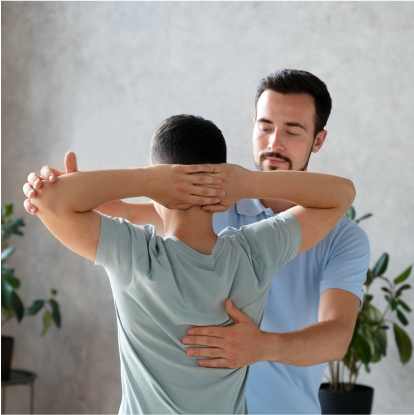Knee Pain Physiotherapy in Brampton
Knee Pain Physiotherapy in Brampton focuses on identifying the source of knee-related discomfort and movement challenges. Whether caused by injury, overuse, or gradual joint changes, knee issues can interfere with walking, bending, and everyday activity. Each plan is developed with a clear understanding of the individual’s symptoms, physical condition, and mobility goals.
Common Knee-Related Conditions
Knee pain can result from mechanical stress, tissue irritation, or injury. At Knee Pain Physiotherapy in Brampton, various conditions are addressed, including:
· Patellofemoral Discomfort
Also called anterior knee pain, this occurs near or around the kneecap and may be related to movement patterns or imbalances in muscle control.
· Meniscus Injury
Cartilage between the upper and lower leg bones may tear or become worn over time, leading to reduced joint efficiency and occasional swelling or clicking.
· Ligament Strain or Tear
Sprains or injuries to stabilizing tissues such as the ACL or MCL are often caused by sudden stops, pivots, or trauma.
· Degenerative Joint Changes
Gradual wear within the knee structure may limit flexibility and affect joint use.
· Tendon Overuse
Repeated movement or impact can result in stress to tendons in the front or back of the knee.
Factors That May Contribute to Knee Pain
Several habits or situations may increase stress on the knee joint:
· Imbalanced Movement
Uneven muscle use, incorrect walking patterns, or hip misalignment may overload the knee.
· Prolonged Inactivity
Limited movement can weaken supportive tissues and reduce joint stability.
· Footwear Without Proper Support
Wearing unsupportive shoes may shift pressure through the legs in a way that increases strain.
· Repetitive Stress
Activities involving regular kneeling, climbing, or jumping may place additional demands on the joint.
· Changes in Body Mass
More weight on the frame increases pressure on the knee with each step.
What Knee Pain Physiotherapy in Brampton Can Involve
The process begins with a full assessment of posture, range of motion, balance, and muscular function. Based on these findings, care may include the following:
Manual Techniques
Hands-on work is used to ease muscle tension, restore alignment, and allow more efficient movement.
Guided Movement
Stretching and strengthening programs are introduced to improve muscle control and reduce joint load.
Movement Pattern Education
Teaching safer techniques for walking, squatting, and stepping can reduce excess pressure on the joint.
Environment and Routine Adjustments
Modifying common tasks, furniture setup, or work positions can help limit irritation throughout the day.
Supportive Modalities
Temperature-based tools or assisted motion exercises may help ease stiffness during the early phase of care.
Knee Conditions Often Addressed
Tracking Issues Around the Patella
Uneven force around the kneecap may cause clicking, grinding, or discomfort when using stairs or sitting for long periods.
Cartilage Injury
Tears or softening of cartilage may cause instability, reduced bending capacity, or locking.
Ligament Involvement
Pain or lack of control after sudden impact or twisting may indicate a strain or partial tear, requiring gradual recovery steps.
Joint Surface Changes
Wear from repetitive use over time may limit how far the knee can bend or extend.
Overused Tendons
Tendons stressed by work or sports may become thickened or irritated, making certain motions difficult or painful.
Session Frequency
Session frequency depends on the stage of recovery. In early stages, care may begin with two to three visits per week. As movement improves and pain levels decrease, sessions may reduce in frequency. The plan adapts to how the individual responds and how much support they need to reach their goals.
What You Can Expect
Knee Pain Physiotherapy in Brampton emphasizes:
- Reducing irritation in the joint and surrounding tissues
- Building strength in muscles that provide support
- Teaching techniques that reduce strain during daily movement
- Identifying limiting patterns and working to change them
- Offering strategies to handle knee discomfort outside the clinic setting

